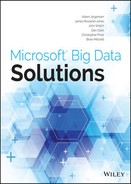
Contents
Chapter 1 Industry Needs and Solutions
Derivative Works and Distributions
Important Apache Projects for Hadoop
Chapter 2 Microsoft's Approach to Big Data
Microsoft's Contribution to SQL in Hadoop
Part II Setting Up for Big Data with Microsoft
Chapter 3 Configuring Your First Big Data Environment
On-Premise Installation: Single-Node Installation
HDInsight Service: Installing in the Cloud
Windows Azure Storage Explorer Options
Logging into HDInsight Service
Verify HDP Functionality in the Logs
Part III Storing and Managing Big Data
Chapter 4 HDFS, Hive, HBase, and HCatalog
Exploring the Hadoop Distributed File System
Explaining the HDFS Architecture
Exploring Hive: The Hadoop Data Warehouse Platform
Designing, Building, and Loading Tables
Configuring the Hive ODBC Driver
Exploring HCatalog: HDFS Table and Metadata Management
Exploring HBase: An HDFS Column-Oriented Database
Defining and Populating an HBase Table
Chapter 5 Storing and Managing Data in HDFS
Understanding the Fundamentals of HDFS
Using Common Commands to Interact with HDFS
Interfaces for Working with HDFS
Administrative Functions in HDFS
Moving and Organizing Data in HDFS
Implementing Data Structures for Easier Management
Chapter 6 Adding Structure with Hive
Understanding Hive's Purpose and Role
Providing Structure for Unstructured Data
Enabling Data Access and Transformation
Differentiating Hive from Traditional RDBMS Systems
Creating and Querying Basic Tables
Using Advanced Data Structures with Hive
Chapter 7 Expanding Your Capability with HBase and HCatalog
Loading Data into an HBase Table
Working with HCatalog and Hive
Integrating HCatalog with Pig and Hive
Using HBase or Hive as a Data Warehouse
Part IV Working with Your Big Data
Chapter 8 Effective Big Data ETL with SSIS, Pig, and Sqoop
Combining Big Data and SQL Server Tools for Better Solutions
Transferring Data Between Hadoop and SQL Server
Getting the Best Performance from SSIS
Chapter 9 Data Research and Advanced Data Cleansing with Pig and Hive
Taking Advantage of Built-in Functions
Executing User-defined Functions
Building Your Own UDFs for Pig
Extending Hive with Map-reduce Scripts
Creating a Custom Map-reduce Script
Creating Your Own UDFs for Hive
Part V Big Data and SQL Server Together
Chapter 10 Data Warehouses and Hadoop Integration
Challenges Faced by Traditional Data Warehouse Architectures
Hadoop's Impact on the Data Warehouse Market
Introducing Parallel Data Warehouse (PDW)
Business Use Cases for Polybase Today
Speculating on the Future for Polybase
Chapter 11 Visualizing Big Data with Microsoft BI
Self-service Big Data with PowerPivot
Rapid Big Data Exploration with Power View
Spatial Exploration with Power Map
Data Science, Data Mining, and Predictive Analytics
Building a Recommendation Engine
Running a User-to-user Recommendation Job
Running an Item-to-item Recommendation Job
Chapter 13 Big Data and the Cloud
Exploring Big Data Cloud Providers
Setting Up a Big Data Sandbox in the Cloud
Getting Started with Amazon EMR
Getting Started with HDInsight
Storing Your Data in the Cloud
Exploring Big Data Storage Tools
Chapter 14 Big Data in the Real World
A New Ecosystem of Technologies
Part VI Moving Your Big Data Forward
Chapter 15 Building and Executing Your Big Data Plan
Gaining Sponsor and Stakeholder Buy-In
Defining the Criteria for Success
Identifying Technical Challenges
Identifying Operational Challenges
Planning for Setup/Configuration
Planning for Ongoing Maintenance
Chapter 16 Operational Big Data Management
Hybrid Big Data Environments: Cloud and On-Premise Solutions Working Together
Ongoing Data Integration with Cloud and On-Premise Solutions
Integration Thoughts for Big Data
Backups and High Availability in Your Big Data Environment
Creating Operational Analytics
System Center Operations Manager for HDP
Installing the Ambari SCOM Management Pack
